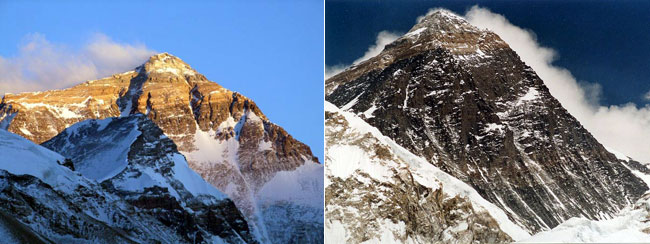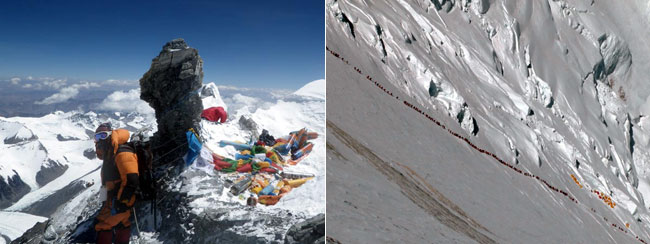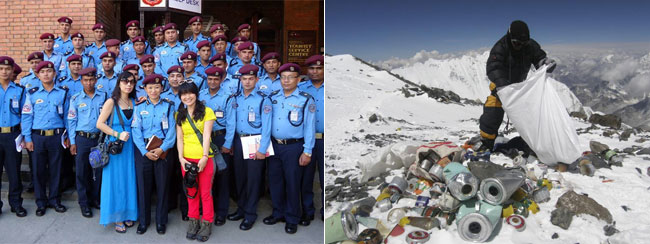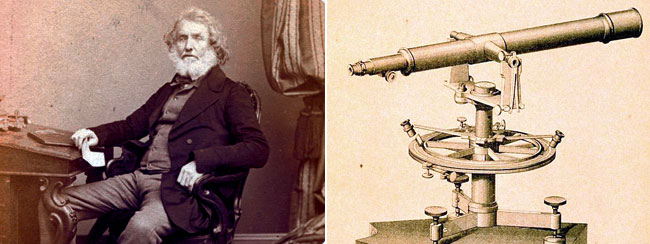With the Everest climbing season nearly upon us there will soon be a flurry of articles in the mainstream media about how the world’s highest mountain has become a garbage dump littered with human corpses which rich people can now be carried up by teams of Sherpas.
Over the next few months I know many journalists with little or no knowledge of Everest or mountaineering will be under pressure from their editors to knock together something emotive at short notice by cutting and pasting from internet websites or phoning up somebody who might have climbed it once for a few urgent soundbites, so I thought I would put together this handy one-stop-shop media guide to save them some time.
1. Everest’s two main sides

Everest has two main sides, the north side, accessed from Chinese Tibet, and the south side, accessed from Nepal. Most people climb the mountain by the Southeast Ridge on the Nepalese side. This route was first climbed by Edmund Hillary and Tenzing Norgay in 1953. The other commercial route is the North Ridge on the Tibetan side. This was first climbed by Wang Fu-chou, Chu Yin-hua and Konbu in 1960, but is better known as the route where George Mallory and Sandy Irvine went missing in 1924. There are also a number of more challenging routes which have only been climbed a handful of times by more gifted climbers. These include the West Ridge, the Southwest Face, the Kangshung Face, and the Northeast Ridge.
As you can see from the photographs above, the mountain looks very different from each side. Before you grab a photo off Flickr to illustrate your article, it’s probably worth establishing which side of the mountain you have been writing about to avoid looking like a muppet.
2. Climbing Mount Everest

One of the reasons Everest has become easier and safer to climb for less gifted mountaineers is the used of fixed ropes on the steeper sections. These enable climbers to clip into the rope using a device known as a jumar, which slides up the rope but locks in place when tugged from below. The jumar is attached to the climber’s harness using a length of cord known as a prussic. This provides two benefits. Firstly, if the climber falls the jumar will hold them, and secondly if they are struggling to climb a difficult technical section they can haul themselves up by tugging on the jumar. This makes climbing both safer and easier, but above 7000m, where the air is thin and breathing is much more difficult, it is still very hard work and the terrain can be difficult. Many articles about Everest make reference to a staircase of fixed lines which enable rich people to be dragged up by Sherpas, but as you can see from the photos above, fixed ropes and staircases are two very different things. Similarly, climbers do not trundle up and down Everest like commuters on an escalator, and suggesting they do will make you sound clueless.
The issue of Sherpas dragging clients up Everest also requires examination. There is a technique known as short-roping where a client is attached to a guide by a short 2 or 3m line of cord, but this technique is usually used on descent, to bring down a climber who is exhausted more safely. While the climber may lack coordination, they do need to have sufficient energy to walk, and it’s not possible to drag them down like a corpse. Short-roping climbers up a mountain is not unknown, but is generally frowned upon and rarely successful, as it is exhausting for both climber and guide, and extremely dangerous at high altitude. Exhaustion and dehydration are two factors which lead quickly to altitude sickness, and short-roped clients and guides are much more likely to suffer fatal conditions such as cerebral and pulmonary edema.
3. Everest clichés

There are a number of tired clichés that get trotted out by the media every time something controversial happens on Everest, many of which have only a flimsy grounding in truth or are ludicrously exaggerated with unselfconscious hyperbole. To save you the bother of Googling for them yourselves I’ve listed a few of the most common ones below.
These have been used so many times by so many people you can happily cut-and-paste them into your articles without fear of copyright infringement. A word of warning, however: you will be contributing to the decline of journalism as a profession, and readers will eventually desert your worthless news sites in favour of better-informed amateur blogs (and hopefully this one as well).
“Mount Everest is not only the highest mountain in the world, it is also the world’s highest garbage dump.”
“Every inch of Mount Everest is littered with refuse, including oxygen bottles, tattered tents and sleeping bags, frayed ropes, old batteries, plastic bottles, food containers, human excrement and the FROZEN CORPSES of the mountain’s hundreds of victims.”
“Thousands of climbers pay up to $65,000 to be dragged up Mount Everest every year, and the numbers are increasing. Many expeditions are led by guides who are more concerned with money than the fragile mountain environment.”
“Sixty years after it was first conquered, tourists complain that the summit of Mount Everest has become virtually gridlocked. Some have said the summit has become as congested as a busy motorway during a bank holiday Sunday, with climbers queueing for as long as six hours to scale the Hillary Step, tripping over FROZEN CORPSES as they wait.”
“There are so many DEAD BODIES on Mount Everest that if you stood them on each others shoulders on top of the summit they would topple over. Some corpses have been there for so long climbers use them as landmarks.”
“Tourist traffic to Mount Everest has increased in recent years, and millionaire clients with virtually no climbing experience fly into base camp to be shepherded up the mountain by international expedition companies.”
“Trash has been building up on Mount Everest for decades, including items such as oxygen cylinders, tents and beer cans, as well as HUMAN CORPSES, which remain frozen where they fell.”
“So many tons of rubbish clog up the world’s highest peak that the Guinness Book of World Records has officially recognised it as the world’s highest garbage dump.”
“More than 4,000 climbers have now scaled the 8848m peak since 1953, when it was first conquered by New Zealand climber Edmund Hillary and his Sherpa guide Tenzing Norgay. Hundreds more have died in the attempt, while many have succeeded only with help from oxygen tanks, Sherpa guides, porters to carry their luggage, and a cocktail of high altitude drugs.”
“You can basically pay to get up Everest these days. As long as they are not too old or weak and can still use both legs nearly everyone can climb it if they have enough money. People without any legs have even climbed it.”
“The Nepalese call the mountain Sagarmatha and consider it to be sacred. They sometimes attribute climbing deaths to bad karma earned through foreign tourists disrespecting the mountain by piling up garbage and dumping human faeces in crevasses.”
“Every year about a quarter of a million tourists travel to Nepal to hike the Himalayas, and over 800 try to scale its highest peak, Mount Everest. About 90 percent of them have no actual climbing skills, and pay up to $100,000 for a guided trip up.”
“The two standard routes on Mount Everest are dangerously overcrowded and disgustingly polluted. Garbage leaks out of the glaciers and pyramids of human excrement turn the high camps into a high altitude toilet. Climbers say the higher they get the worse the trash problem gets.”
“Following a violent confrontation at Mount Everest Base Camp last year, when a mob of over two hundred angry Sherpas armed with knives threatened to kill a group of western climbers who had insulted them, the government of Nepal has slashed climbing fees by more than half in order to encourage even more visitors.”
4. Government announcements

The government of Nepal feels that media coverage of Everest over the last few years has tarnished its image. While it might seem logical for them to work with expedition operators and climbers to address some of the problems that have contributed to this, they have instead decided to act unilaterally and counter the bad press by making a number of bizarre announcements, which most expedition organisers have only found out about through the media.
The announcements are usually accompanied by a series of random quotes by government officials, whose names and job titles sound fictional if vaguely plausible. Here is a summary of the more recent announcements, together with some handy quotes to paste into your articles. While the quotes are genuine, I have changed the names of people to avoid pointing the finger of blame at any particular individual.
- Police are to be stationed at Everest Base Camp following a brawl at 22,000 ft last year.
“With police at base camp, Nepalese liaison officers — who accompany expeditions to ensure they abide by local laws — will no longer have to report incidents at the nearest police station a seven-day trek away.” Madsadhu Snottibhotti, chief of the Handwringing Division at the Ministry of Tourism
What Mr Snottibhotti didn’t mention is that in reality the majority of expedition liaison officers are notorious for staying at home and pocketing their fee, only turning up at base camp for a token photograph for the family album. For more about the base camp police force you can read my previous post about it.
- Each climber will now be required to carry 8kg of trash down from the high camps.
“We are not asking climbers to search and pick up trash left by someone else. We just want them to bring back what they took up.” Ungriandi Adhikuri, chief of the Penpushing Division at the Department of Waste and Sewage
When this announcement was first made it was unclear whether climbers were expected to bring down litter left by previous teams. Not only is much historical trash frozen in place, but 8kg is an awful lot of additional weight for an exhausted climber struggling through a dangerous obstacle like the Khumbu Icefall, and many teams would transfer this duty to their hard-working Sherpas instead. Later announcements, such as the above quote, suggest this is not the case. Nobody is disputing that clearing up the detritus left by many previous expeditions on the south side going back to 1951 is a good thing, but it will be interesting to see whether this particular plan is workable. Reputable teams already pack out their own trash from the high camps, so a directive to bring down 8kg would be meaningless anyway.
- Mountaineering fees have been slashed from $25,000 to $11,000
“We brought about this change after seeing widespread malpractice. We have seen that in order to reduce the royalty cost per member, separate expeditions with separate team leaders managed by different organizers decided to go as one group. But once they are at the Mt Everest Base Camp, the teams split and operate independently.” Ang Shagging Sherpa, head of the Mountaineering Division at the Ministry of Culture
In fact for most climbers permit fees have increased from $10,000 to $11,000 since almost everyone climbed under a group permit anyway, which until now has been $70,000 for 7 climbers. By making individual permits the same price as group permits there is a danger the south side of Everest will see a return of the mavericks who plagued the north side until recently.
- Climbers will now be expected to attend an intensive pre-orientation programme designed by government authorities to avert any untoward situation during the climbing period
“There will be a special pre-orientation programme for the climbers and their helpers to alert them on dos and don’ts to maintain peace in the region. The orientation programme is aimed at averting any untoward situation.” Andi Gandhi, head of Naughty Step at the Ministry of Ethics
Perhaps the strangest announcement of all is this one, which seems to be a direct response to last year’s incident involving the superstar climbers Ueli Steck and Simone Moro. It’s not unique for climbers to attend a pre-expedition briefing on commercial peaks – climbers on Denali in Alaska receive a presentation from the national park rangers – but these briefings usually focus on safety and waste management rules (Denali climbers are given a green bucket to crap into). This particular announcement seems to be about preventing fights, which until last year have never been a huge problem.
5. Everest nomenclature

Everest is named after Sir George Everest, Surveyor-General of India from 1830 to 1843 by his successor in the post Andrew Waugh in 1865. Legend has it that an Indian surveyor called Radhanath Sikhdar rushed into Waugh’s office in 1852 clutching a piece of paper scribbled with trigonometric calculations. “Sir, I have discovered the highest mountain in the world,” he is supposed to have cried.
The name was controversial because British surveyors from the Survey of India had a directive to find local names for geographical features wherever possible. There is reasonable evidence that the local Tibetan name of Chomolungma was available to them if they wanted to use it. Chomolungma has been translated variously as Unmoveable Goddess Who is a Benefactress of Bulls, Unshakeable God Elephant Woman, Land of the Hen Birds, The Peak Above the Valley, and The Mountain So High No Bird Can Fly Over It, but its usual translation is Mother Goddess of the Earth. The name Sagarmatha, meaning Brow of the Sky in Sanskrit, is used to describe Everest in Nepal, but this name is even more recent than Everest.
It’s not necessary to call it Mount Everest. You can simply call it Everest if you like and most people will know what you are talking about. While the word Everest could also refer to Sir George Everest, a UK manufacturer of double glazing, or a slang term for an impossible task or an ultimate ambition, its use in a mountaineering context is unlikely to confuse anyone. It’s worth bearing in mind the word Mount has other connotations for some readers. For example, the Biblical phrase “Moses went to Mount Olive”, also describes an action that would have enraged Popeye.
Here endeth the media primer on Mount Everest. Of course, not all journalists give their profession a bad name, and should the good ones stumble across this post I hope they find it entertaining if not particularly useful. If you think I’ve missed anything, as I’m sure I have, then please post it in the comments.






Great overview Mark. I’m sure thousands of “journalists” will be in your debt. Hey, you forgot one: sleep in an altitude tent before you leave for Everest,arrive pre-acclimitized allowing anyone to climb Everest in a week! Helicopter out to brag at the Rum Doodle to your conquest ….
Heehee, thanks Alan. “Thousands of journalists” – what was that about hyperbole? 😉
Yes, I’d forgotten about the bragging at Rum Doodle’s. There needs to be a quote about ticking a box in our bucket list in there too!
You two keep me very happy most of the time but Everest Season is bliss. Thanks for the refresher course ! I have been very busy re-reading books and checking over DVD,s. If I am so manic about Everest sitting in an armchair it is easy to understand why mountaineers wish to climb “the big one”. I love all the mountains but apart from it being the highest I’m not quite sure what drives me to its slopes time and time again. I suppose it’s because it gets so much publicity, both good and bad. I feel to know every twist and turn of its wondrous slopes. When the season finishes it’s almost like a bereavement and the thought of having to wait a year for the next session makes me a little sad. Well boys thanks again in anticipation, you go a long way to ease the disappointment of not being able to have a go myself. In my day we used to count ourselves lucky if we could put in a trip to the Cairngorms each year. Still, my four children are all sporty and they have managed the Himalayas a time or two. Of course I don’t enjoy their trips until they return, it’s then when I become a mum !!! Hope you both enjoy the season and that your news is as good as it can be statistics allowing. Cheers and thanks again Kate
Hi Mark.
We should all hope that professional journo’s never sink to the level of “copy and paste” but i Cant wait til 2015 and we’ll be getting not one but two high octane slices of entertainment regarding our fave mountain that they surely won’t be able not to comment on.
Firstly, we have” Everest” (original,I’ll grant you) starring that square jawed thespian Benedict Cumberbatch. It’s based on Jeffo Archer’s account of George Mallory,screenplay written by someone named Sheldon Turner who I presume has read the book that you so accurately described as crap I think..I might not be quite accurate there but the sentiment is correct.
Secondly we have “Everest” (don’t say it…please) this time starring Jake Gyllenhaal. This ones about,and I quote the IMDB website. “A hiking expedition on Everest is devastated by a severe snow storm”. It’s the 1996 tale revisited again by Hollywood. Jake plays the Scott Fischer character..,
Hopefully,both slices of these future classics will inspire and educate…there will be a new group of potential climbers who having seen and been inspired themselves will be rushing to their nearest website to book on their “trip of a lifetime”.
Finally, I think this response may qualify more for your mountain “porn” article last week. After all, those journo’s will have a field day after watching two Everest tales and picking the bones from them. Art imitating life !!!!!! I don’t think so.
Regards as always.
Martin
Heehee, you’re absolutely right Martin. You’ve accurately summarised my assessment of Lord Archer’s novel Paths of Glory in that long blog post I wrote in a single word. I’ll spare reviewing those two films you refer to then – my expectations aren’t high. 😉
On a separate note, most news organisations sink to the level of cut and paste, be that from news wires, press releases or less legitimately other web sites. Here are two examples I came across only this morning. Let me know which one you think is the original. My money’s on neither of them:
http://timesofindia.indiatimes.com/world/south-asia/Nepal-mulls-leasing-Himalayan-peaks-to-private-tourism-companies/articleshow/31852595.cms
http://www.ndtv.com/article/world/nepal-mulls-leasing-himalayan-peaks-official-494353
I’m starting to believe your knowledge is mostly rubbish and for pay. Very reminiscent of a whiny teenage girl that boasts too much about mediocre accomplishments.
Re Andy Hanes. He can’t be serious ! Can he ? I think I’ve had enough amusement for one night. If we are choosing Mark I think I go with the second option. Cheers Kate
Very nice piece. Ive climbed a bit in Nepal and Tibet and these annual stories, designed to stir up feelings among the masses of “normal” people does make me slightly angry. Ive lost count of the number of times Ive had to explain to non climbing friends that it really isn’t like the sensationalist journalists have described!
Hi Mark….
Went through your post. I know you respect the Everest.
But just mention how much waste and garbage you brought back after your expedition was over.
Prabesh
Nepal
Hi Prabesh
I don’t know how much there was in total but we packed it all out with us when we left.
Regards,
Mark.
Popeye..now that made me laugh!
Pingback:Whewell’s Gazette: Year 3, Vol. #47 | Whewell's Ghost